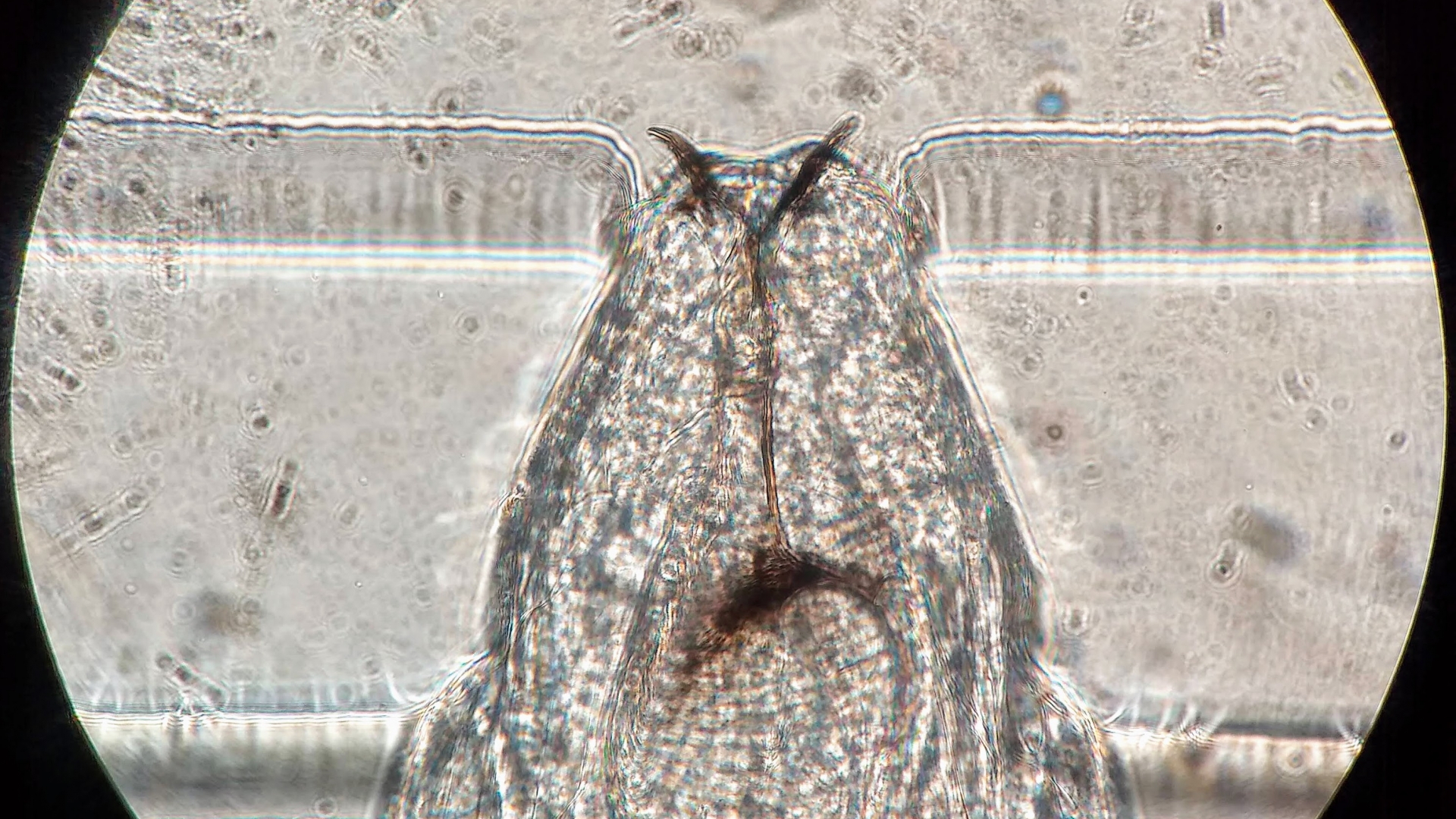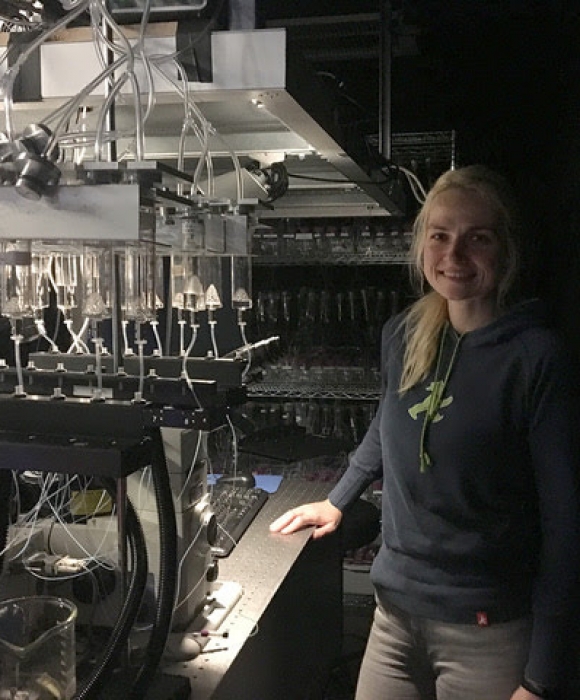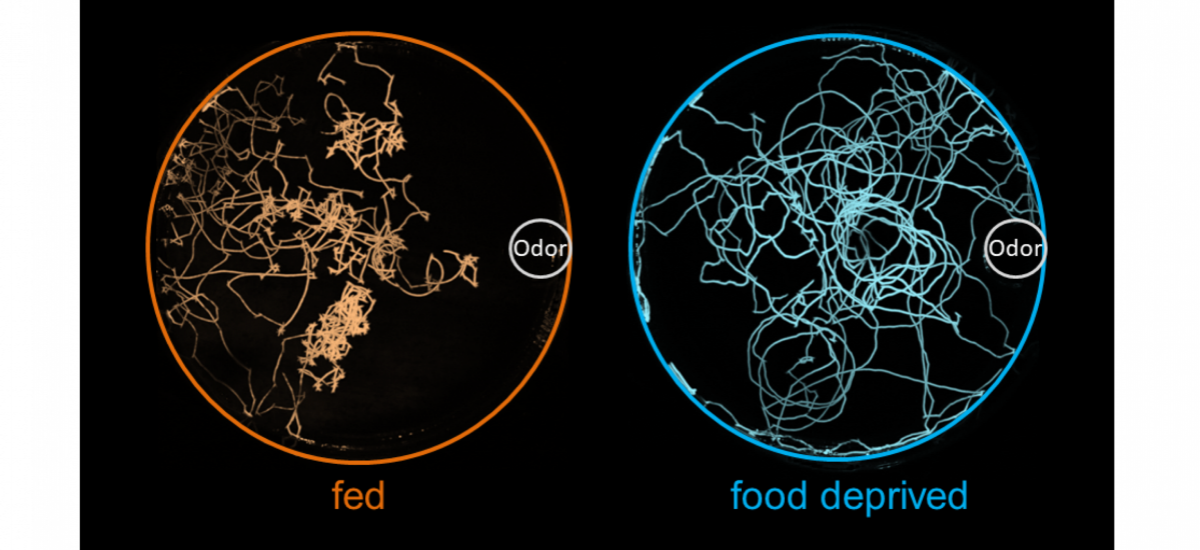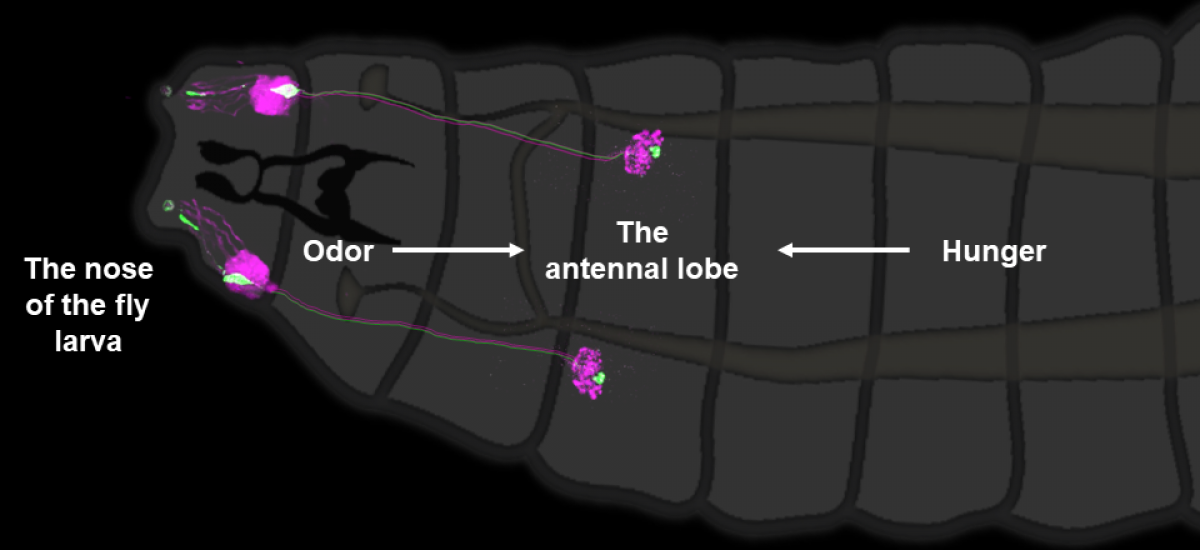
Navigationstitel
Reihenfolge von Text/Bild
Biologist Dr Katrin Vogt from the University of Konstanz is studying how hunger and other internal states control behaviour
Does this situation appear familiar to you? You go shopping on an empty stomach and notice at the checkouts that more – and mostly unhealthy – products have found their way into your shopping cart than originally planned. Unconsciously, your brain has told you to still your hunger by buying lots of high-calorie food, such as chocolate and frozen pizzas. In her junior research group at the University of Konstanz, biologist Dr Katrin Vogt is using vinegar fly larvae to study how the brain controls behaviour depending on hunger and other internal states. She is discovering astonishing parallels between humans and flies.

The vinegar fly as a scientific all-rounder
Katrin Vogt already developed a passion for insects and especially the vinegar fly (Drosophila melanogaster), often more commonly known as the “fruit fly”, during her student days in Würzburg and Munich. In her theses, she studied how these animals learn about odours and colours. She has remained faithful to the vinegar fly as a model organism at the later stages in her career, such as Tohoku University (Sendai, Japan), Harvard (Cambridge, USA), and now the University of Konstanz. “Once the fly, always the fly,” she says, commenting on her career so far with a laugh. However, she also stresses that the great diversity of behavioural research at Konstanz would give her the possibility to consider other insect species in her future research.

However, the advantages of the vinegar fly as a model organism for behavioural neuroscience research, Katrin Vogt’s specialist field, are obvious: The vinegar fly is one of the most extensively studied animal species in the world. Accordingly, current biological research methods used to study vinegar flies are already established and ready for application. These range from high-precision genetic tools, such as the CRISPR/Cas “genetic scissors”, to methods for the targeted activation and observation of single brain cells, such as optogenetics and calcium imaging. Furthermore, the larva of the vinegar fly is one of the very few organisms for which a complete “wiring diagram” of the brain exists, something known as a connectome.
"The possibility to systematically combine detailed knowledge of the larva’s brain structure with various high-precision genetic and neurobiological methods is what’s special about the vinegar fly. It gives us the opportunity to illuminate questions from all sides."
Dr Katrin Vogt
In the beginning was the connectome
In the framework of her most recent study, which has just appeared in the journal Science Advances and originates from her time as a post-doctoral researcher at Harvard, Katrin Vogt and her colleagues have examined how hunger influences the behaviour of vinegar flies and what exactly happens in the animals’ brains in the process. The idea for this came to her while looking at the “wiring diagram” of the vinegar fly’s brain. “Looking at the connectivity pattern of the nerve cells in the first olfactory centre of the fly larva, known as the antennal lobe, we presumed that there must be at least two different states of activity in the olfactory system. We wanted to know what causes the transition between these two states of activity and arrived at hunger as a possibility,” explains Katrin Vogt. As it turned out, she and her fellow researchers evidently had a good nose.

With the help of classical behavioural tests, Katrin Vogt first of all showed that hungry fly larvae are attracted to certain plant odours, while sated larvae prefer to keep a distance. Just like with us humans when we go shopping, hunger is the state here that controls whether certain types of food are accepted or rejected. “Since feeding is essential for fly larvae before pupation, hungry larvae also take food sources into consideration that would not be interesting enough for a sated larva,” Katrin Vogt explains.

In several years’ research work and using the methods mentioned above, Katrin Vogt and her colleagues have also successfully shed light on the entire control mechanism of the behavioural change observed in the brain of the fly larva and simulated it in a computer model. In the process, they arrived at a number of unexpected results. Firstly, the place in the larva’s brain where the observed behaviour is controlled, especially the role played by the antennal lobe, completely surprised experts.
“Previously, we had assumed that the antennal lobe was primarily a relay station for sensory information on its way deeper into the brain. However, we were able to show that a lot of information processing already takes place there, such as the integration of the hunger state,” says Katrin Vogt. In addition, it emerged that the activity of a single nerve cell is responsible for switching the antennal lobe from sated to hungry state and thus for controlling the behaviour the researchers had observed.
From insect to mammal
From the brain of the fly larva, with its around 10,000 neurons, to the human brain, with about 10 million times as many nerve cells, is a big jump. To answer the question whether our brain controls our buying behaviour in the same way when we are hungry, as the brain of the fly larva does control its feeding behaviour, further research is needed. There are, however, clear indications of parallels between insects and mammals in the circuitry of nerve cells.
For example, the single nerve cell which controls the hunger behaviour observed among vinegar fly larvae uses the neurotransmitter serotonin. This has a similar function in most animals and regulates mood. Comparable to the serotonergic neuron of the fly larva, which sends signals from deep in the brain to the insect’s first olfactory centre, mammals also have serotonergic nerve cells which connect from the brainstem back to our first olfactory centre.
"Similar circuitry patterns are found in the brains of insects and mammals. And even if these circuits might differ in detail as far as their function is concerned, the basic mechanisms of the neural processing of internal states such as hunger could well be of a conserved nature and function according to the same principles in different animal groups."
Dr Katrin Vogt
What happens next
Like with all neuroscientists, the goal of Katrin Vogt’s research is to understand how brains function. “In my last research project, I learnt a lot about how hunger, as one of several internal states, influences olfactory perception and the feeding behaviour of fly larvae. In my opinion, it’s time now to challenge the larva’s brain a little more,” she says.
That is why in future she would like to study, together with her new working group in Konstanz, how conflict situations have an impact on larval behaviour: How, for example, do they react to an appealing olfactory stimulus in a brightly lit area, which the light-sensitive larvae would normally avoid? How does the brain decide in such contradictory situations? Or what influence do hunger and other internal states, such as tiredness or stress, have here on decision-making?
Apart from gaining insights useful for basic neurobiological research, Katrin Vogt also sees clear application possibilities for her research in the medium to long term, for example in the area of artificial intelligence (AI). Current AI applications are often modelled on those regions of the mammalian brain responsible for processing sensory stimuli and are therefore particularly good at certain repetitive tasks, such as image recognition or speech processing. Real brains, however, accomplish much more. They are flexible and adaptable, even when faced with unknown or contradictory situations.
"It’s this plasticity that makes real brains so fascinating and which current AI applications lack. I think that informatics and the computer sciences can learn a lot more here from the insect’s brain. Because the insect’s brain is also capable of a remarkably flexible performance, although it functions with far less nerve cells than that of mammals.”
Dr. Katrin VogtCaptions:
- Home: Head of a fly larva under the microscope.
- Page 2: System for odour presentation during calcium imaging.
- Page 4: Fly rearing vials: one generation of fly breeding from egg laying (right) through various intermediate stages (centre) to pupation (left).
- Page 8: Movement trajectories of 15 fed (left) and 15 hungry (right) fly larvae. Both groups were presented with the same odour. Fed larvae move away from the odour, hungry larvae move towards it.
- Page 10: Stained olfactory cells, which transport the odour information from the larva's nose to the antennal lobe.
- Copyright of all photos: Katrin Vogt
- 1When fly larvae are hungry
- 2Introduction
- 3The vinegar fly as a scientific all-rounder
- 4The vinegar fly as a scientific all-rounder
- 5The vinegar fly as a scientific all-rounder
- 6Quote
- 7In the beginning was the connectome
- 8In the beginning was the connectome
- 9In the beginning was the connectome
- 10In the beginning was the connectome
- 11In the beginning was the connectome
- 12From insect to mammal
- 13Quote
- 14What happens next
- 15Quote
- 16Captions